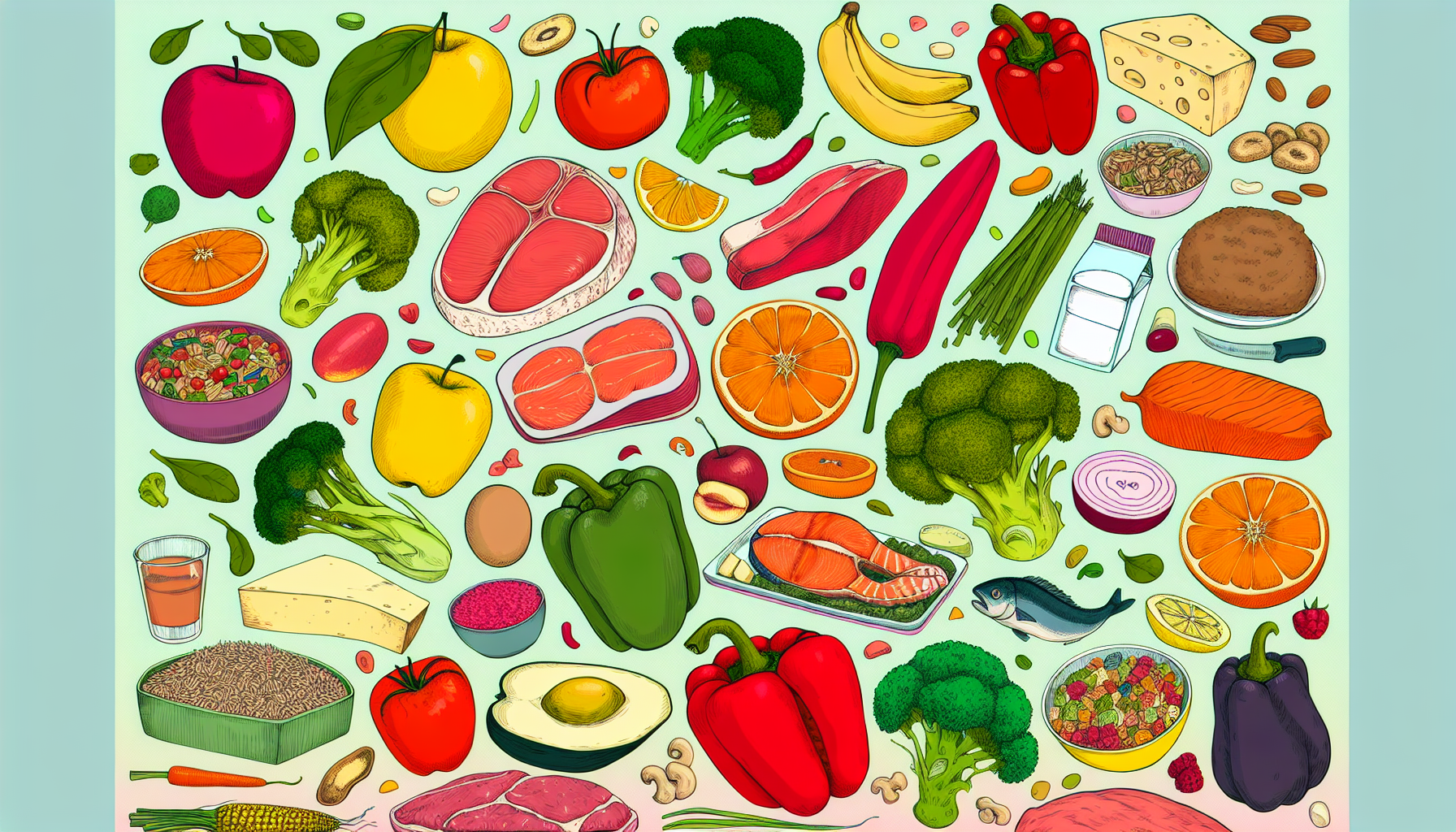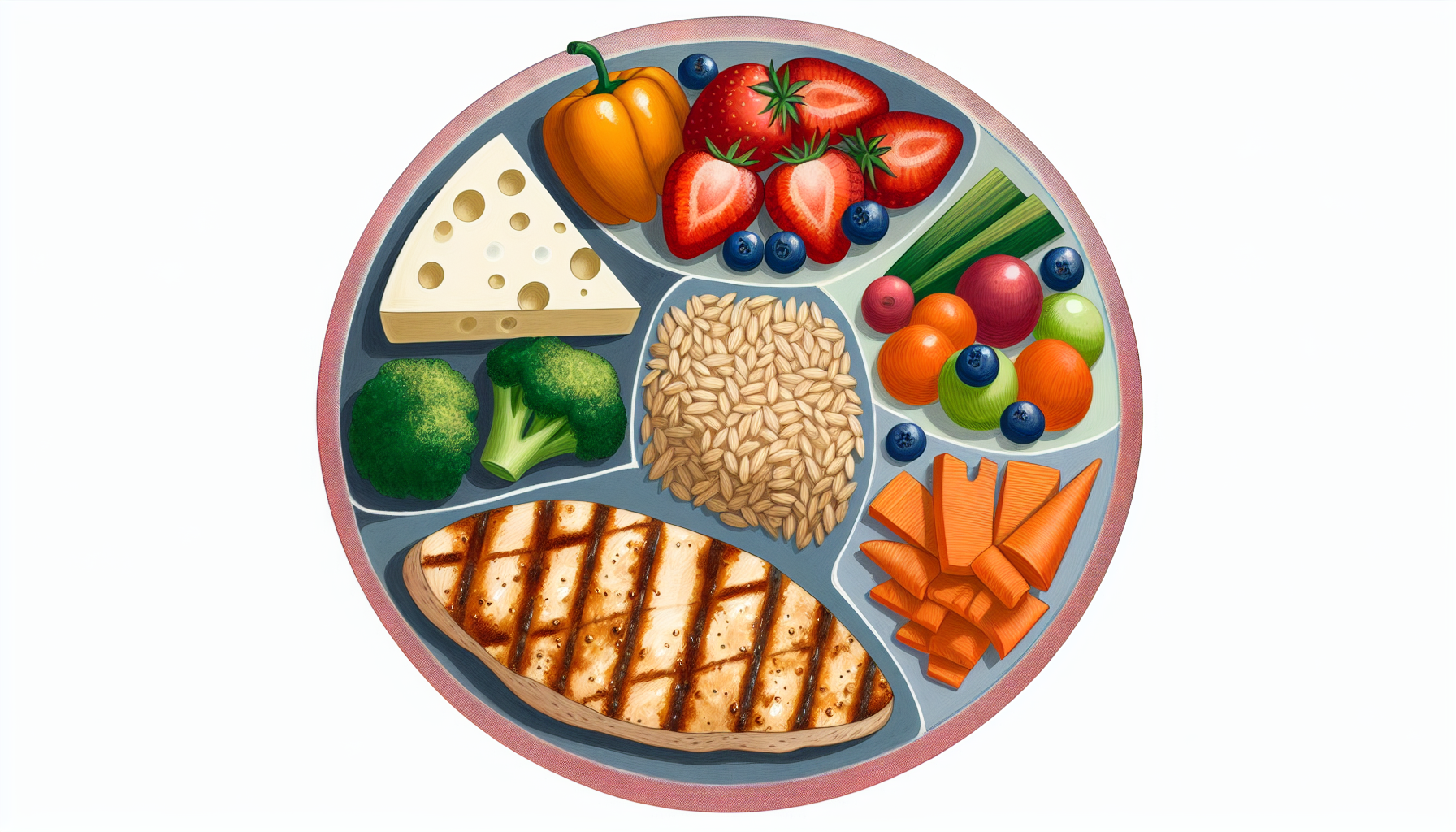Are you looking to nourish a growing teenager or are you a teen aiming for a healthier diet? Navigating teen nutrition can be tricky with rapid growth and changing bodies. Teenagers need a diet rich in proteins, fats, carbohydrates, vitamins, minerals, and water to support their development. This article breaks down the fundamentals of a balanced diet for teens, addressing specific energy, macronutrient, and micronutrient needs, without being overly technical or preachy. Dive in to understand how to construct a nutritious and satisfying eating plan for the teen in your life.
Table of Contents
ToggleKey Takeaways
- Adolescents require a diet rich in proteins, fats, carbohydrates, vitamins, minerals, and water to support their growth and hormone regulation, with specific energy needs that peak during early adolescence.
- A balanced diet for teenagers should consist of whole grains, a variety of protein sources, fruits and vegetables, and limited added sugars, saturated and trans fats, as well as sodium to support health and prevent disease.
- Promoting healthy eating habits, incorporating regular physical activity, ensuring adequate sleep, and involving teens in meal planning are fundamental to their overall health and development.
Teenage Nutritional Needs

Adolescence brings the biggest growth spurt since infancy. As teenagers navigate these changes, their bodies require more energy and certain essential nutrients. These include:
- Proteins
- Fats
- Carbohydrates
- Vitamins
- Minerals
- Water
These six essential nutrients are needed for proper growth and hormone regulation. Dietary guidelines suggest a varied diet to ensure these key nutrients are adequately consumed.
Good nutrition isn’t just about what teens eat; it’s also about how much they eat. The amount a teenager needs to eat depends on their growth and activity levels. We will now explore these nutritional needs in more detail.
Energy Requirements
During early adolescence, the body’s demand for calories peaks, surpassing any other life stage. This increase in energy requirements is a response to the growth spurts that occur during the teen years. On average, boys require about 2,800 calories per day, while girls need around 2,200 calories per day. These daily calorie requirements can decrease once a teenager’s growth spurt ends. However, physically active adolescents may continue to require more calories.
Significantly, girls often consume about 25% fewer calories than boys during middle and late adolescence, potentially causing deficiencies in essential vitamins and minerals.
Macronutrients
Complex carbohydrates, proteins, and fats are all essential macronutrients that teens need. Complex carbohydrates should make up 50% to 60% of a teenager’s caloric intake. These carbs are converted into glucose, which serves as the body’s primary fuel source for sustained energy.
Proteins are a cornerstone of growth, cell maintenance, hormone production, and antibody development. Fats, although often vilified, are actually crucial for energy provision and the absorption of fat-soluble vitamins A, D, E, and K. Nonetheless, we should keep in mind that not all macronutrients are equally beneficial. For instance, fat provides 9 calories per gram, while both protein and carbohydrates provide just 4.
Micronutrients
While macronutrients get most of the attention, micronutrients, available in small doses, play a significant role in a teenager’s health and development. Specifically, the following micronutrients are critical for bone growth and development during adolescence:
- Calcium
- Phosphorus
- Iron
- Zinc
- Vitamin D
Vitamin D, for instance, not only promotes calcium absorption but also supports proper muscle function. Additionally, vitamins function as powerful antioxidants. They have the potential to decrease the likelihood of developing conditions like lung and prostate cancer.
Advisably, teenagers should derive these vitamins and minerals primarily from a diverse diet, including fruits, vegetables, and lean proteins. Some good sources of essential nutrients for teenagers include:
- Green leafy vegetables
- Broccoli
- Soybeans
- Dairy products
These foods are part of the protein foods group, which contributes to a diet rich in vitamins and minerals like vitamin K and calcium.
Building a Balanced Diet

Having understood the nutritional needs of teenagers, we will now explore building a balanced diet. The focus should be on incorporating a variety of:
- proteins
- fats
- carbohydrates
- vitamins
- minerals
- water
To support health, economic growth, and disease prevention, it is essential for systems, including the immune system, to function properly by incorporating a balanced diet with nutrients like those found in lean meat, such as lean beef.
Dietary guidelines suggest a diet that consists of:
- 45% to 65% of calories from carbs, focusing on fruits, vegetables, whole grains, and beans rather than added sugars and refined grains
- Maintaining hydration is critical, with teens needing adequate water each day from beverages and water-rich foods such as fruits and vegetables
- Foods with added sugars should be limited as they offer little nutritional value and can displace healthier options.
Protein Sources
Protein plays a vital role in the growth and development of teenagers. It provides essential amino acids that the body can’t make on its own and must be obtained from food. Sources of essential amino acids include:
- meat
- fish
- eggs
- beans
- soy
- nuts
- some grains
To ensure a full profile of essential amino acids, teenagers must consume a variety of protein sources.
Fruits and Vegetables
Adding a diverse array of fruits and vegetables to meals provides a wide range of vitamins and minerals that support various bodily functions. For example, carotenoids, found in carrots, are converted by the body into vitamin A, which plays an important role in maintaining eye health.
The idea is to incorporate fruits and vegetables into every meal, for example, including fruits in breakfast or snacks and adding vegetables to lunch and dinner.
Whole Grains
Whole grains should make up at least half of a teenager’s grain intake. They are high in fiber, which helps teens feel fuller for longer. Replacing refined grains with whole grains, such as brown rice, barley, and whole-wheat pasta, increases dietary fiber intake and provides more nutrients.
Instead of sweetened breakfast cereals and pastries, teens should opt for whole grain, low-sugar alternatives.
Making Healthy Choices: Foods to Limit or Avoid
Knowing which foods to include in a teenager’s diet is crucial, but understanding which ones should be limited or avoided is equally vital. For example, trans fats and saturated animal-based fats, found in butter, cheese, red meat, ice cream, and high-fat fast foods like burgers and fries, should be limited.
Processed snacks, such as chips and crackers, are often high in trans fats and contain significant amounts of added sugar and sodium, posing potential health risks.
Saturated and Trans Fats
Saturated and trans fats can be detrimental to heart health. Saturated fats can increase levels of total cholesterol and tip the balance toward more harmful LDL cholesterol, contributing to arterial blockages and heart issues. Trans fats raise LDL cholesterol and lower HDL cholesterol, which is associated with heart disease.
Foods high in saturated fats, also known as high fat foods, should be replaced with those containing unsaturated fats, like nuts, seeds, fish, and certain vegetable oils, to reduce the risk of heart disease.
Added Sugars
Excessive consumption of added sugars can increase the risk of:
- obesity
- heart disease
- certain cancers
- tooth decay
These sugars contribute to high calorie intake without providing any nutritional value or satiety, leading to an energy imbalance and potential weight gain.
The American Heart Association recommends limiting added sugar intake to 6 teaspoons per day for women and 9 teaspoons per day for men.
Sodium
High sodium intake can lead to fluid retention and strain on the heart, contributing to high blood pressure. Consuming high-sodium fast-food items can result in elevated blood pressure and increase the risk of heart disease and stroke over time.
The recommended daily limit for sodium is less than 2,300 mg for adults, with an ideal limit of no more than 1,500 mg for those with hypertension. To reduce sodium intake, it’s best to choose fresh, unprocessed foods, and check food labels for sodium content.
Physical Activity and Teen Health

In addition to a balanced diet, physical activity plays a significant role in teenage health. Teenagers should engage in at least 30 minutes of physical activity per day as part of a balanced lifestyle. Healthy growth and development during teenage years necessitate regular physical activity.
Promoting overall well-being can be achieved by incorporating physical activity into a teenager’s daily routine.
Top Ten Fun and Effective Workouts for Teenagers to Build Healthy Habits
Recommended Activity Levels
The Centers for Disease Control and Prevention (CDC) recommends that teens engage in at least 60 minutes of moderate to vigorous physical activity daily. This should include a combination of aerobic, muscle-strengthening, and bone-strengthening exercises throughout the week. Teenagers should perform muscle-strengthening activities at least three days per week as part of their 60 minutes of daily exercise.
Appropriate exercises for teens include a variety of activities such as team sports, swimming, jogging, martial arts, dance, strength training, and yoga.
Balancing Screen Time
In the digital age, balancing screen time with physical activity is crucial. Implementing household rules that limit the duration of screen time per day can assist in reducing sedentary behavior among teenagers. Encouraging teens to take frequent breaks from screen time to stretch or do quick physical activities can help mitigate the effects of prolonged sitting.
Setting up tech-free zones or times, like during family meals or an hour before bedtime, can help teenagers disconnect and engage in more physical activities. Limiting sedentary activities like watching television and computer use to less than 2 hours daily can encourage more physical activity and healthier lifestyle habits.
Sleep and Teen Nutrition

Sleep is another crucial aspect of teenage health. Sleep deprivation in adolescents is related to increased appetite and higher calorie consumption, potentially leading to overeating and weight gain. Poor sleep quality can lead to increased snack consumption along with higher intakes of calories, fats, and carbohydrates.
Consistent sleep routines and good sleep hygiene in adolescents are associated with better dietary choices and potentially achieving a healthy weight.
Sleep Recommendations
Teenagers need 9 to 9½ hours of sleep per night, about an hour more than what they needed at age 10. Insufficient sleep can lead to a range of health issues, including:
- Increased risk of obesity
- Impaired cognitive function
- Poor academic performance
- Increased risk of mental health problems
- Increased risk of accidents and injuries
It is important for teenagers to prioritize getting enough sleep to support their overall health and well-being.
The overall health and well-being of teenagers greatly depend on adhering to sleep recommendations.
Establishing Healthy Sleep Habits
Apart from getting the recommended amount of sleep, it’s also important to have good sleep habits. Regulating teens’ sleep patterns and reducing the time it takes for them to fall asleep require maintaining consistent sleep and wake times, including on weekends.
Improving sleep quality in teenagers involves practicing good sleep hygiene, such as:
- Limiting evening caffeine intake
- Keeping a consistent sleep schedule
- Avoiding electronics at bedtime
- Creating a distinction between sleeping, relaxing, and study areas.
Encouraging Healthy Eating Habits

An integral part of teenagers’ overall health is the encouragement of healthy eating habits. Promoting balanced meal choices and teaching nutritional guidelines can be achieved by involving teenagers in meal planning. Assigning responsibility for menu planning and cooking to teens can enhance their cooking skills and promote food autonomy.
Encouraging teenagers to pack their own leftovers teaches food responsibility and waste reduction.
Family Meals
Family meals are a great opportunity for teens to engage in meaningful conversations with their parents, contributing positively to their development and well-being. The frequency of family meals may be less crucial than the quality of interaction during them, and aiming for manageable goals like one good family meal each week can lead to positive outcomes.
Allowing teens to determine their own portion sizes during family meals respects their ability to recognize feelings of hunger and fullness and supports a healthy relationship with food.
Setting Realistic Goals
Setting realistic health goals can promote a proactive approach to health. Encouraging teenagers to set personal health goals can give them a sense of ownership over their nutritional choices. Here are some examples of specific, measurable goals they can set:
- Try a new fruit or vegetable each week
- Eat at least 2 servings of fruits and 3 servings of vegetables every day
- Include a salad or a side of vegetables with every meal
By setting these goals, teenagers can make healthier choices and improve their overall nutrition.
Setting small, realistic goals for family meals, such as participating in meal preparation once a week, can help solidify eating habits and enhance family relationships.
Summary
In essence, a teenager’s diet should be diverse and balanced, incorporating a variety of proteins, fats, carbohydrates, vitamins, minerals, and water to support health and growth. Unhealthy fats, processed snacks, and foods high in added sugars and sodium should be limited. Physical activity, adequate sleep, and good sleep habits are equally important for a teenager’s overall health and well-being. Engaging in regular family meals and setting realistic health goals can promote balanced meal choices and teach teens nutritional guidelines. Let’s foster a generation of healthy, informed, and confident young people who understand the value of nutrition and take charge of their health.
Frequently Asked Questions
Should a 13 year old have a diet?
Yes, a 13-year-old should have a diet that includes a variety of nutritious foods and meets their daily nutritional needs for growth and development. It’s important for them to eat well-balanced meals and limit snacks high in fat, sugar, or salt.
How many calories should a teenager eat a day?
On average, active teenage boys need around 2,600 to 3,200 calories a day, while teenage girls who are active may need 2,200 to 2,400 calories daily. This can vary based on age and activity level, but a balanced diet and healthy meal plan are key.
What are the six essential nutrients needed during teenage years?
To ensure proper growth and hormone regulation during teenage years, it’s important to include vitamins, minerals, protein, fats, water, and carbohydrates in your diet.
Why should teenagers limit their intake of saturated and trans fats?
Teenagers should limit their intake of saturated and trans fats because they can raise cholesterol levels, leading to potential heart problems.
How much physical activity should teenagers engage in daily?
Teens should engage in at least 60 minutes of moderate to vigorous physical activity every day, as recommended by the Centers for Disease Control and Prevention (CDC).
Share this post: on Twitter on Facebook on Google+








